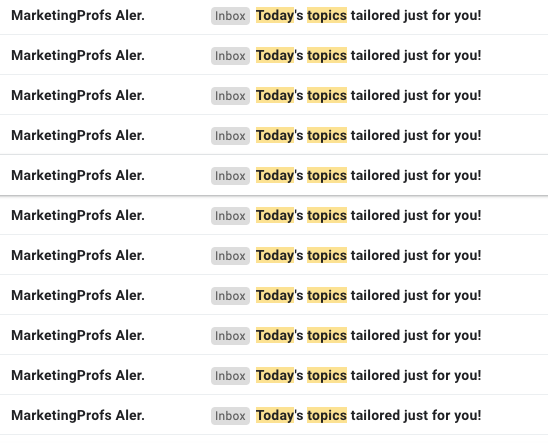This post originally appeared in the February 6, 2020 issue with the email subject line "How should an email be?" and a review of market-leading email marketing platform Mailchimp.
Technically email is almost 50 years old, which makes sense, actually. It’s good to think of email as a medium for grownups. Because the kids don’t check email anymore, at least anecdotally. (Email marketing studies will disagree with me, but you try to identify someone under 25 who is really into reading email.)
But those of us who grew up with email: we love it, at least for content. We love our Substacks and our Revues and our publication newsletters. Email newsletters remind me of the early days of blogging, internet golden ages, salad days. I read and subscribe to many of them.
I also read a lot of bad email. For most B2B publications, I can read the most recent list of links via email without the annoyance of popups or display ads on their crappy websites, but most publications’ email content strategy could use an update.
Here’s what I tell clients and people who want to learn more about writing an email newsletter. Email is for attentive, reading audiences, so create emails aimed at people who pay, subscribe and read. Stop thinking of emails as anonymous “blasts” and start thinking of them as “fan clubs.”
1. Email should add value.
Email is ideal for introducing new information and analysis to regular readers. Your email audience has opted in to hear from you (hopefully). They want you in their inbox.
![Coop says, "I want you inside me" from Wet Hot American Summer [gif]](https://cdn.substack.com/image/fetch/w_1456,c_limit,f_auto,q_auto:good/https%3A%2F%2Fbucketeer-e05bbc84-baa3-437e-9518-adb32be77984.s3.amazonaws.com%2Fpublic%2Fimages%2Fc2e5ea04-0a2a-4cd8-9447-5182045b7e72_500x291.gif)
A good email does not reiterate the same exact list of links that appear on your website, written slightly differently; a good email gives me a reason to be in my inbox, away from my other apps, away from the web. A good email can be read over lunch or a commute. A good email is a reward.
Value can be additional commentary, thoughts, or humor. It can be information on new software features, the kinds of news that isn’t worth a press release but might be of interest to your fans. If you’re on the content marketing side, it can be a special offer for your best customers (i.e., the ones that regularly read your emails). It can even be a fucking coupon, although that repetition loses value if every email is a coupon.*
The best content blooms within the medium where it’s planted. An email is not a website, especially not in 2020. Email doesn’t have to be discovered in a search engine. It should not have too many ads, as your email is already an ad for you. We, the audience, have already opted in. (BTW, if you don’t have an opt-in only email list, you should move to a permission-based email strategy.)
*I once worked at a bar that had coupons and it was the worst. Only brought in bargain-seekers and not solid regulars. Coupons and deeply discounted offers need to go the way of the dodo. Get outta here, 20th century business strategies. Gimme something more sustainable.
2. Email can be more content-experimental than almost any other medium.
Because of the audience opt-in, we can take some chances. Email remains an amazing medium for experimenting with voice and content. Feel free to give your audience new tastes of what you’re cooking up. New imagery, sneak previews of other content, works in progress… all are great for email. If you’re having fun, your audience will join in.
![The professor does a science experiment on Gilligan's Island [gif]](https://cdn.substack.com/image/fetch/w_1456,c_limit,f_auto,q_auto:good/https%3A%2F%2Fbucketeer-e05bbc84-baa3-437e-9518-adb32be77984.s3.amazonaws.com%2Fpublic%2Fimages%2F912d9d4d-5b1c-4b84-9d44-a7fa607010be_480x270.gif)
Email is long-form but ephemeral. It’s your own private club, so make every meeting worth it. Your club members will like seeing new ideas once in a while.
If you’re going to experiment, I recommend introducing it little by little, to one section or pillar at a time. Keep everything else consistent.
3. Keep email consistent.
Like any subscription-based product, your audience wants to know what to expect, even if you’re experimenting. Having a regular format and defined departments/pillars will help you both plan and execute your content on schedule. You don’t need more than 2-3 sections, one long and one short.
Aim for consistency in open rates (30%+ if you’re doing a content-based email).
Depending on whether people care about your brand, either the subject line matters a ton — but once people care and recognize your brand, they’ll open the email no matter what. Opening the email becomes at best a pleasurable reward and at worst, a habit.
![A nun straightens her habit [gif]](https://cdn.substack.com/image/fetch/w_1456,c_limit,f_auto,q_auto:good/https%3A%2F%2Fbucketeer-e05bbc84-baa3-437e-9518-adb32be77984.s3.amazonaws.com%2Fpublic%2Fimages%2Fb728001f-49a8-4216-b1e6-d9901501e435_480x202.gif)
How often should you send content-driven email? That has more to do with you than your audience: you should send email at the frequency you can realistically regularly maintain. If that’s monthly, then that’s monthly.
I don’t recommend daily emails unless you’re keeping them very short and providing a daily recommendation or link. Daily open rates can drop easily, and you run the risk of fading into the background. Know your limits. A daily is a lot of work, and with the amount of good dailies in the market, may be approaching the point of diminishing returns.
But remember: unless your audience is super tolerant and into Saving It For Later it’s better to send shorter content weekly than one long email monthly. (Or you could be like me and send one really long email weekly, longer than you ever intended it to be.)
4. If you can’t make it look great consistently, keep it simple.
There’s no reason to make someone’s inbox an explosion of color unless that’s part of your brand. Designing email templates for multiple clients is notoriously a pain in the ass, time consuming, expensive. Now we have dark mode, rapidly adopted across platforms and phones… for which even this simple newsletter isn’t yet optimized.
Amazon Web Services accidentally sent out its template recently, and since Amazon is slowly destroying the world, we can at least see how they’re so effective at it: their design is quite simple. Image, a sprinkle of text, CTA.
(But then again… add value. Don’t just send a CTA to my inbox unless it will help me in some new way.
And I would never expect the audience for a marketing email to read every sentence, though. Unless those sentences are really good, but if you’re writing them on the daily… they’re not that good, just tedious.)
5. Don’t expect readers to click more than one link.
In fact, don’t expect them to click any links at all. But if they click, they will likely only click one. This is true of every single email I’ve ever worked on — with this newsletter or many, many others with far larger audiences.
It’s an email. Keep your best content in the email. You can repurpose elsewhere, but as I said about blooming…
![A rose blooms [gi]](https://cdn.substack.com/image/fetch/w_1456,c_limit,f_auto,q_auto:good/https%3A%2F%2Fbucketeer-e05bbc84-baa3-437e-9518-adb32be77984.s3.amazonaws.com%2Fpublic%2Fimages%2F768b5eea-50d1-45ea-a110-74adb6fc5f5c_500x316.gif)
6. If you do send a lot of email, ensure your customer has control over the content and frequency.
Please! The majority of us want that control. Set up a customer preference center if you’re sending a lot of emails.
![Emarketer gif displaying that users want more control over both email frequency and content [gif]](https://cdn.substack.com/image/fetch/w_1456,c_limit,f_auto,q_auto:good/https%3A%2F%2Fbucketeer-e05bbc84-baa3-437e-9518-adb32be77984.s3.amazonaws.com%2Fpublic%2Fimages%2F2f1c0e16-ec42-4ecc-84f4-a9703253cf68_484x350.png)
Dynamic content is a great idea for sending less email to different audiences, as long as you’re using it to provide value. Using dynamic content can also shorten production time while addressing different audiences.
Just don’t over-personalize it so you’ve overcomplicated your system.
Hand-picked related content







